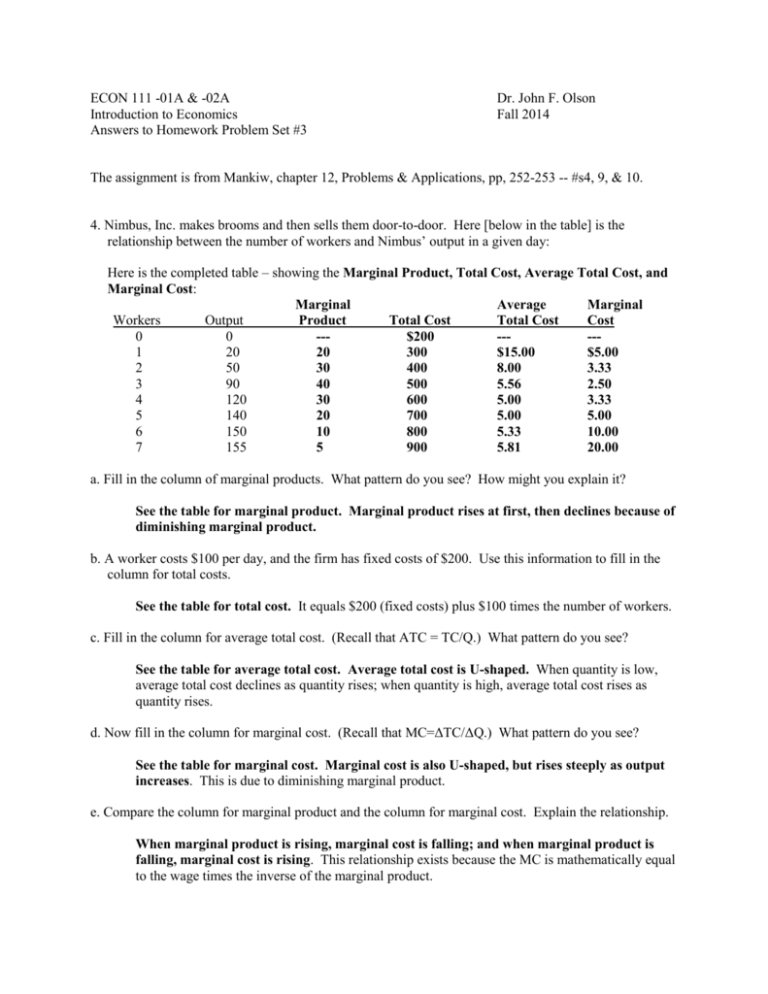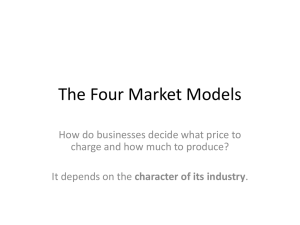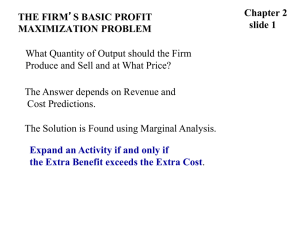HWPS#3
advertisement

ECON 111 -01A & -02A Introduction to Economics Answers to Homework Problem Set #3 Dr. John F. Olson Fall 2014 The assignment is from Mankiw, chapter 12, Problems & Applications, pp, 252-253 -- #s4, 9, & 10. 4. Nimbus, Inc. makes brooms and then sells them door-to-door. Here [below in the table] is the relationship between the number of workers and Nimbus’ output in a given day: Here is the completed table – showing the Marginal Product, Total Cost, Average Total Cost, and Marginal Cost: Marginal Average Marginal Workers Output Product Total Cost Total Cost Cost 0 0 --$200 ----1 20 20 300 $15.00 $5.00 2 50 30 400 8.00 3.33 3 90 40 500 5.56 2.50 4 120 30 600 5.00 3.33 5 140 20 700 5.00 5.00 6 150 10 800 5.33 10.00 7 155 5 900 5.81 20.00 a. Fill in the column of marginal products. What pattern do you see? How might you explain it? See the table for marginal product. Marginal product rises at first, then declines because of diminishing marginal product. b. A worker costs $100 per day, and the firm has fixed costs of $200. Use this information to fill in the column for total costs. See the table for total cost. It equals $200 (fixed costs) plus $100 times the number of workers. c. Fill in the column for average total cost. (Recall that ATC = TC/Q.) What pattern do you see? See the table for average total cost. Average total cost is U-shaped. When quantity is low, average total cost declines as quantity rises; when quantity is high, average total cost rises as quantity rises. d. Now fill in the column for marginal cost. (Recall that MC=ΔTC/ΔQ.) What pattern do you see? See the table for marginal cost. Marginal cost is also U-shaped, but rises steeply as output increases. This is due to diminishing marginal product. e. Compare the column for marginal product and the column for marginal cost. Explain the relationship. When marginal product is rising, marginal cost is falling; and when marginal product is falling, marginal cost is rising. This relationship exists because the MC is mathematically equal to the wage times the inverse of the marginal product. f. Compare the column for average total cost and the column for marginal cost. Explain the relationship. When marginal cost is less than average total cost, average total cost is falling; the cost of the last unit produced lowers the average. When marginal cost is greater than average total cost, average total cost is rising; the cost of the last unit produced raises the average. 9. Jane’s Juice Bar has the following cost schedules [in the table below, showing for the quantities, the variable and total costs]: a. Calculate average variable cost, average total cost, and marginal cost for each quantity. The table below shows average variable cost (AVC), average total cost (ATC), and marginal cost (MC) for each quantity. Quantity 0 1 2 3 4 5 6 Variable Cost $0.00 10.00 25.00 45.00 70.00 100.00 135.00 Total Cost $30.00 40.00 55.00 75.00 100.00 130.00 165.00 Average Variable Cost --$10.00 12.50 15.00 17.50 20.00 22.50 Average Total Cost --$40.00 27.50 25.00 25.00 26.00 27.50 Marginal Cost --$10.00 15.00 20.00 25.00 30.00 35.00 b. Graph all three curves. What is the relationship between the marginal-cost curve and the average-totalcost curve? Between the marginal-cost curve and the average-variable-cost curve? Explain. The figure below shows the three curves. The marginal-cost curve is below the average-total-cost curve when output is less than four and average total cost is declining. The marginal-cost curve is above the average-total-cost curve when output is above four and average total cost is rising. The marginal-cost curve lies above the average-variable-cost curve. 10. Consider the following table of long-run total costs for three different firms [the total costs are shown in the first row for each firm, in the second rows are the calculated average costs]: Quantity = Firm A - TC AC Firm B - TC AC Firm C - TC AC 1 $60 60.00 $11 11 $21 21.00 2 $70 35.00 $24 12 $34 17.00 3 $80 26.67 $39 13 $49 16.33 4 $90 22.50 $56 14 $66 16.50 5 $100 20.00 $75 15 $85 17.00 6 $110 18.33 $96 16 $106 17.67 7 $120 17.14 $119 17 $129 18.43 Does each of these firms experience economies of scale or diseconomies of scale? Firm A has economies of scale because average total cost declines as output increases. Firm B has diseconomies of scale because average total cost rises as output rises. Firm C has economies of scale from one to three units of output and diseconomies of scale for levels of output beyond three units.








